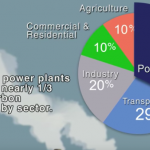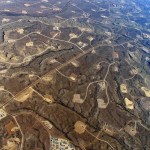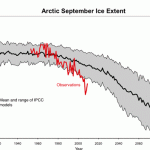methane
The US is already behind in its agreed to commitment to clean power
A study just out in Nature climate Change suggests that the US is already behind in its commitments to reduce the use of fossil fuel as an energy source, and the concomitant release of climate-warming greenhouse gasses into the atmosphere.
The paper, by Jeffery Greenblatt and Max Wei, says:
Current intended nationally determined contributions (INDCs)are insufficient to meet the Paris Agreement goal of limiting temperature change to between 1.5 and 2.0◦C above pre-industrial levels, so the effectiveness of existing INDCs will…
No joke: California Governor Jerry Brown signed a bill to regulate 'gas' emissions from cows along with other sources of greenhouse gases, of course. According to an interview from NPR, dairy cows are the number one producer of methane in California. The problem with methane is that it is a major component of smog, although according to scientists at the University of California Santa Barbara, it is not the leading cause of global warming. In fact, agriculture-related methane and carbon dioxide emissions are responsible for only 6-7% of greenhouse emissions…
Research makes it increasingly clear that along with drilling for oil and mining coal, extracting natural gas from deep underground causes serious damage to the environment and to public health. On The Pump Handle, Kim Krisberg examines the contamination that may result from dumping fracking wastewater into disposal wells, writing "about 1,000 different chemicals are used in the fracking industry, with more than 100 being known or suspected endocrine disruptors." Researchers collected water samples downstream from wells in West Virginia, and after "exposing both female and male mammalian sex…
Arctic sea ice decline happened faster than expected. This has the effect of accelerating global warming because less of the Sun's energy is reflected back into space by ice.
Northern Hemisphere snow also sends some of that energy back into space. The amount of snow cover we have is also declining.
Difference from average annual snow extent since 1971, compared to the 1966-2010 average (dashed line). Snow extents have largely been below-average since the late1980s. Graph adapted from Figure 1.1 (h) in the 2012 BAMS State of the Climate report.
The warming of the Arctic region is also…
Researchers observed tiny voids forming in silicon used for solar panels; these voids provide physical evidence of the Staebler-Wronski effect, "which reduces the solar cell efficiency by up to 15 percent within the first 1000 hours."
Using an online avatar with a skin color other than your own makes you less racist in real life; playing a hero makes you less cruel, and playing a villain less benevolent.
Old mouse muscles exhibit "elevated levels of activity in a biological cascade called the p38 MAP kinase pathway" which prevents stem cells from dividing and repairing muscle damage. By…
On April 2nd, I posted three iconic graphs showing some of the clear observational evidence that we’re changing the climate. That post produced a substantial, and largely thoughtful response, and a request for more information and data along these lines.
Here are three more, along with a bonus fourth, all with a theme of exponential growth – the powerful force that is behind much of the concern about climate change and many other environmental and social challenges. Figures like these are increasingly called “hockey stick” curves, after the work of Professor Michael Mann and others in the…
You may have heard that the release of greenhouse gases has recently gone down, to match levels of several years ago. Why, then, do we have someone saying that greenhouse gasses have reached a new record high?
There are two, maybe three, reasons.
First, even though CO2 release from the US may be lower now than it has been in a few years, it is still high (it was high a few years ago, so we've reduced to a level that is high!). More importantly, the US has reduced its release of CO2 primarily for incidental economic reasons. With a recession/depression going on, there is less money being…
Wosis then? Is it the sea ice? Ah, no. Someone else wants in on the limelight: "Parts of Arctic Siberia are releasing ten times more carbon into the atmosphere than previously thought, a University of Manchester scientist and an international team of researchers have found."
Its the usual stuff:
much more greenhouse gas is being released into the atmosphere than previously calculated, from and ancient an large carbon pool held in a permafrost along the 7,000 km desolate coast of northernmost Siberian Arctic – dramatically increasing global warming. As the temperature climbs carbon, stored in…
The extent of Arctic sea ice undulates like a yearly sine wave—rising in October, peaking in winter, and melting all spring and summer. This September we are likely to observe the lowest of lows; Greg Laden writes "There is less sea ice in the Arctic Circle than recorded in recent history." More ice has also melted in Greenland this season, with 4 weeks still to go. Greg says, "glacial melting is both more important than one might think and also more complicated." For example, the albedo of Greenland's ice sheet (the proportion of sunlight reflected back into the atmosphere) varies depending…
"Everyone is a moon, and has a dark side which he never shows to anybody." -Mark Twain
Back before the telescope was invented, Saturn was known as the Old Man of the Skies. The slowest-moving of the naked-eye planets, it's the only one that would reliably be in nearly the same location, year after year. You can find it all summer, after sunset, by following the "arc" of the handle of the big dipper all the way until you run into the brightest northern-hemisphere star, Arcturus, and then speeding on to the very bright Spica. Saturn is right next door.
Image credit: EarthSky.org.
But…
Arctic Methane Emergency Group? refers. Via GP I find this discussion on a "geoengineering" newsgroup (gosh how quaint - people still use newsgroups? Maybe retro is back). AJL finds my article "damming" but Ken C finds it "a little distasteful". But both are worried, quite rightly, about credibility if the AMEG's wilder claims (and people) aren't challenged.
Ken C points to September Arctic sea ice predicted to disappear near 2oC global warming above present (JGR, doi:10.1029/2011JD016709) which is interesting, because that is very non-catastrophic and very non-nearterm: 2 oC puts it at ~2070…
From Climate 'tech fixes' urged for Arctic methane I find ameg.me who say:
AMEG POSITION
DECLARATION OF EMERGENCY
We declare there now exists an extremely high international security risk* from abrupt and runaway global warming being triggered by the end-summer collapse of Arctic sea ice towards a fraction of the current record and release of huge quantities of methane gas from the seabed. Such global warming would lead at first to worldwide crop failures but ultimately and inexorably to the collapse of civilization as we know it. This colossal threat demands an immediate emergency scale…
I've said before (and correctly sourced the original observation to JA) that atmospheric methane is way below its IPCC scenarios (which of course leads to a lower forcing). There is a recent thing in Nature that may explain this:
Atmospheric methane (CH4) increased through much of the twentieth century, but this trend gradually weakened until a stable state was temporarily reached around the turn of the millennium1, 2, after which levels increased once more3. The reasons for the slowdown are incompletely understood, with past work identifying changes in fossil fuel, wetland and agricultural…
Debating the merits and dangers of fracking shale gas has become a major obession of those who worry about energy and the climate. Yale's e360's latest contribution comes in the form a forum that includes a wide variety of perspectives pro and con.
For me, the wisest observation, and the one that really trumps all others, comes from Kevin Anderson, who directs the Tyndall Centre for Climate Change Research's energy program:
... the only responsible action with regard to shale gas, or any "new" unconventional fossil fuel, is to keep it in the ground -- at least until there is a meaningful…
A couple days ago I received this note:
"There was an article in the Huffington Post not long ago about an extreme worst case scenario with the oil spill - that a giant methane bubble bursts through the sea floor, ignites, causes a huge supersonic tsunami that would wipe out all of Florida, followed by a vaporization tsunami.
I've heard this described as "disaster porn", and certainly, the scenario smacks of it. But, there have been extreme natural disasters in the past, and not being a geologist, I can't help but feel some alarm at this, as I'm currently a resident of Tampa. I have…
(Just a note: The giveaway period for the audiobook of The Poisoner's Handbook has ended. If your comment is not published, it's too late to be considered for a free copy. But still glad to hear your ideas! Winners to be notified on Wednesday).
One of the most interesting - and I think important - comment threads on this blog has concerned risks posed by the gas methane, blamed (along with BP) for the devastating oil spill in April and still seeping into the water from the broken drill pipe.
"We don't know the composition of the crude oil as it is leaving the well head. This crude is…
On Saturday night, about 9 p.m., a short, sharp explosion rattled one of Russia's largest coal mines, a deep maze of underground tunnels located in Siberia. About 370 miners were working at the time.
Most of them came hurrying out of mine entrances. But not all. Managers organized rescue teams and sent about 50 people back into the Raspadskaya mine to hunt for survivors - and bodies. In the best of circumstances - which would not be in the panic of an emergency, in the middle of the night - this would be a daunting task. The mine's tunnels (an estimated 200 miles worth) plunge…
A nice site about our blue planet's blueness, The Reef Tank, asked to repost a recent ocean related article of mine and did so here.
Always worth checking them out!
Recently, at events for my book, I sometimes find myself describing the gas carbon monoxide as a favorite poison. "It's just so efficient," I'll joke. "And I like things that work."
In an academic sense, I do respectfully admire carbon monoxide's simplicity (a carbon atom + an oxygen atom) and the way such basic chemical addition creates something so deadly. But in light of last week's mining disaster in West Virginia (the subject of two previous posts on this blog), I want to acknowledge that poisonous efficiency is mostly a formula for tragedy.
If you followed the news reports on the fiery…
The old mining term for explosive gases in coal mines is "firedamp". It seems illogical - I mean, a damp fire? - until you realize that it comes from the German word "dampf" for vapors.
There are other "damps" in mining terminology - "afterdamp", for instance, refers to the poisonous gas carbon monoxide, which tends to build up in mines after an explosion. But firedamp explicitly refers to a gas mixture rich in the flammable gas methane, which - as the recent disaster in West Virginia's Upper Branch Mine reminds us - burns like a devil's torch. Twenty-five miners were killed outright in the…





